Are you questioning what you are able to do with the WordPress features file?
All WordPress themes include a features.php file. This file acts as a plugin, permitting theme builders and normal customers so as to add {custom} code in WordPress simply.
On this article, we are going to present you some helpful tips for the WordPress features file.
What Is the Features File in WordPress?
The features.php file is a WordPress theme file that comes with all free and premium WordPress themes.
It acts as a plugin and permits theme builders to outline theme options. Customers also can use it so as to add their {custom} code snippets in WordPress.
Nonetheless, maintaining {custom} code in your theme’s features file just isn’t one of the best ways to save lots of your customizations. For those who replace your theme, then the features.php file will probably be overwritten, and you’ll lose your {custom} code snippets.
As a substitute, we advocate everybody use WPCode, a free plugin that permits you to insert code snippets into your WordPress web site with out modifying any theme, plugin, or core WordPress information.
The most effective half is that every one your {custom} code is saved individually, so any WordPress updates received’t take away them.
As a bonus, the WPCode plugin has an intensive library of pre-configured code snippets (together with many on this record). You’ll be able to deploy these code snippets with a number of clicks.
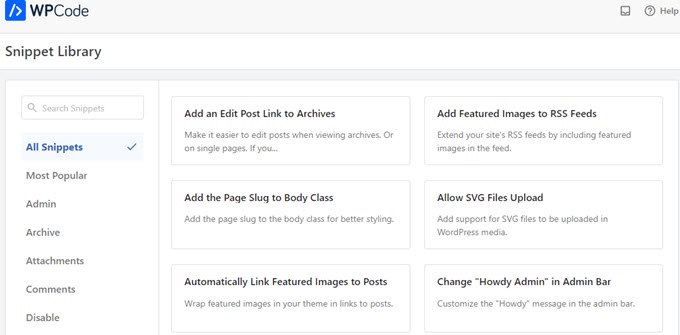
Having mentioned that, here’s a record of things we are going to cowl on this article. You’ll be able to soar to at least one that pursuits you or just observe alongside:
The right way to Add These Code Snippets to Your Web site
Earlier than we start, let’s have a look at find out how to add the code snippets on this article to your WordPress features file.
1. Add Customized Code to Features File Utilizing WPCode (Really useful)
First, you should set up and activate the WPCode plugin. For extra particulars, see our step-by-step information on find out how to set up a WordPress plugin.
Upon activation, go to Code Snippets » + Add Snippet web page. You’ll see WPCode’s code library with many beneficial {custom} code snippets already added.
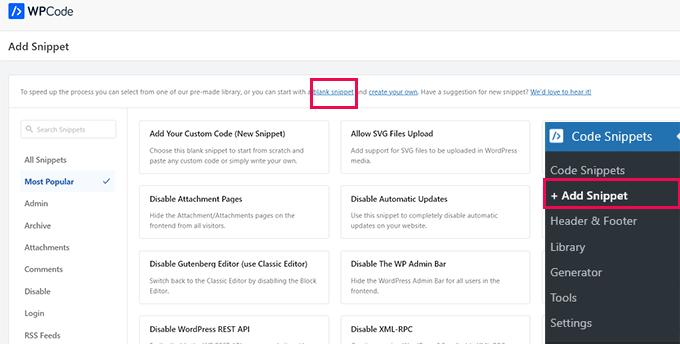
In case your code snippet does the identical factor as of the snippets within the library, then you may check out the one already added there.
Alternatively, click on the ‘clean snippet’ hyperlink to proceed including your {custom} code snippet.
On the following display screen, present a title in your {custom} code. This may very well be something that helps you establish what this code snippet does.

Subsequent, you should select the ‘Code Sort’. In case you are including a code that works within the features.php file, then you should choose ‘PHP Snippet’.
Beneath that, you should copy and paste your {custom} code into the ‘Code Preview’ field.
Lastly, you should set your snippet as ‘Lively’ and click on the ‘Save Snippet’ button.
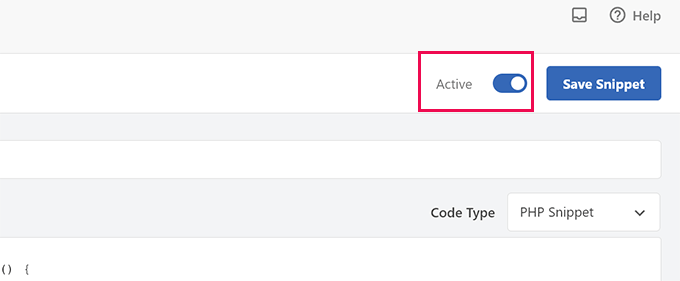
Your saved snippet will now run like it could in case you had added it to the features.php file.
You’ll be able to repeat the method so as to add extra snippets when wanted. It’s also possible to deactivate a snippet with out deleting it.
2. Add Customized Code On to the Features File
The WPCode methodology is at all times higher than including code to the theme’s features file.
Nonetheless, some customers could also be writing code for a consumer’s {custom} WordPress theme or just favor so as to add code to the features.php file.
In that case, right here is how one can add code to your WordPress theme’s features.php file.
First, hook up with your WordPress web site utilizing an FTP consumer. As soon as linked, navigate to the /wp-content/themes/your-wordpress-theme/ folder.
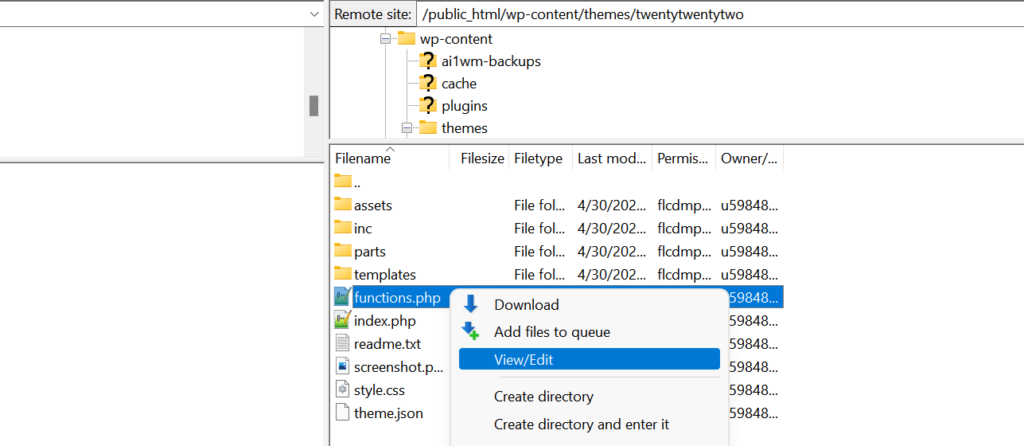
There one can find the features.php file. Merely right-click and choose to edit or obtain the file to your pc for modifying.
You’ll be able to edit it utilizing any plain textual content editor like Notepad or TextEdit.
Then, scroll all the way down to the underside of the features.php file and paste your code snippet there. It can save you your adjustments and add the up to date features.php file to your theme folder.
Now you can go to your WordPress web site to see your {custom} code in motion.
Now, let’s check out 42 completely different helpful tips for the WordPress features file.
1. Take away WordPress Model Quantity
You need to at all times use the most recent model of WordPress. Nonetheless, you might need to take away the WordPress model quantity out of your website.
Merely add this code snippet to your features file or as a brand new WPCode snippet:
return ”;
}
add_filter(‘the_generator’, ‘wpb_remove_version’);
For detailed directions, see our information on the proper approach to take away the WordPress model quantity.
2. Add a Customized Dashboard Brand
Need to white-label your WordPress admin space? Including a {custom} dashboard brand is step one within the course of.
First, you’ll have to add your {custom} brand to your theme’s photos folder as custom-logo.png. Your {custom} brand must be in a 1:1 ratio (a sq. picture) in 16×16 pixels.
After that, you may add this code to your theme’s features file or as a brand new WPCode snippet:
echo ‘
<model sort=”textual content/css”>
#wpadminbar #wp-admin-bar-wp-logo > .ab-item .ab-icon:earlier than {
background-image: url(‘ . get_bloginfo(‘stylesheet_directory’) . ‘/photos/custom-logo.png) !necessary;
background-position: 0 0;
colour:rgba(0, 0, 0, 0);
}
#wpadminbar #wp-admin-bar-wp-logo.hover > .ab-item .ab-icon {
background-position: 0 0;
}
</model>
‘;
}
//hook into the executive header output
add_action(‘wp_before_admin_bar_render’, ‘wpb_custom_logo’);
For extra particulars, see our information on find out how to add a {custom} dashboard brand in WordPress.
The footer within the WordPress admin space exhibits the message ‘Thanks for creating with WordPress.’ You’ll be able to change it to something you need by including this code:
add_filter(‘admin_footer_text’, ‘remove_footer_admin’);
Be happy to alter the textual content and hyperlinks that you simply need to add. Right here is the way it appears to be like on our take a look at website.
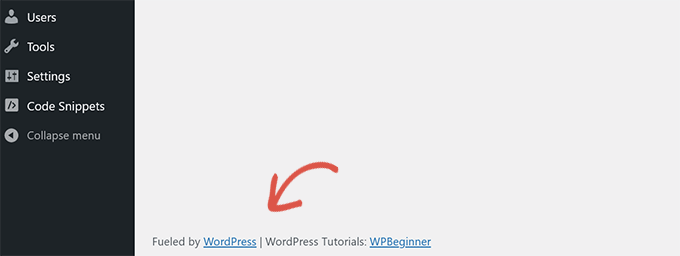
4. Add Customized Dashboard Widgets in WordPress
You in all probability have seen the widgets that many plugins and themes add to the WordPress dashboard. You’ll be able to add one your self by pasting the next code:
perform my_custom_dashboard_widgets() {
international $wp_meta_boxes;
wp_add_dashboard_widget(‘custom_help_widget’, ‘Theme Help’, ‘custom_dashboard_help’);
}
perform custom_dashboard_help() {
echo ‘<p>Welcome to Customized Weblog Theme! Need assistance? Contact the developer <a href=”mailto:[email protected]”>right here</a>. For WordPress Tutorials go to: <a href=”https://www.wpbeginner.com” goal=”_blank”>WPBeginner</a></p>’;
}
That is what it could seem like:
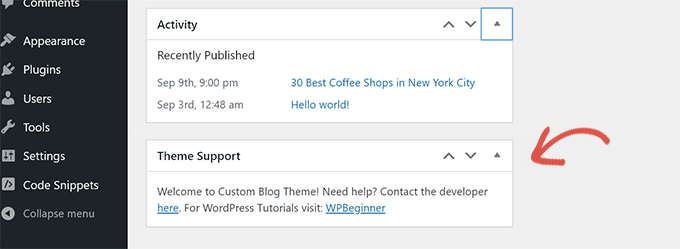
For particulars, see our tutorial on find out how to add {custom} dashboard widgets in WordPress.
5. Change the Default Gravatar in WordPress
Have you ever seen the default thriller man avatar on blogs? You’ll be able to simply substitute it with your individual branded {custom} avatar.
Merely add the picture you need to use because the default avatar and add this code to your features file or the WPCode plugin:
$myavatar=”https://instance.com/wp-content/uploads/2022/10/dummygravatar.png”;
$avatar_defaults[$myavatar] = ‘Default Gravatar’;
return $avatar_defaults;
}
add_filter( ‘avatar_defaults’, ‘wpb_custom_default_gravatar’ );
Now you may head to the Settings » Dialogue web page and choose your default avatar.
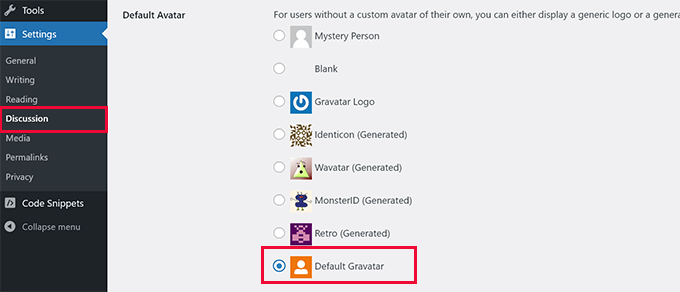
For detailed directions, see our information on altering the default gravatar in WordPress.
6. Dynamic Copyright Date in WordPress Footer
You’ll be able to merely add a copyright date by modifying the footer template in your theme. Nonetheless, it is not going to present when your website began, and it’ll not mechanically change the next yr.
This code can add a dynamic copyright date within the WordPress footer:
international $wpdb;
$copyright_dates = $wpdb->get_results(”
SELECT
YEAR(min(post_date_gmt)) AS firstdate,
YEAR(max(post_date_gmt)) AS lastdate
FROM
$wpdb->posts
WHERE
post_status=”publish”
“);
$output=””;
if($copyright_dates) {
$copyright = “© ” . $copyright_dates[0]->firstdate;
if($copyright_dates[0]->firstdate != $copyright_dates[0]->lastdate) {
$copyright .= ‘-‘ . $copyright_dates[0]->lastdate;
}
$output = $copyright;
}
return $output;
}
After including this perform, you’ll have to open your footer.php file and add the next code the place you wish to show the dynamic copyright date:
This perform appears to be like for the date of your first put up and the date of your final put up. It then returns the years wherever you name the perform.
Tip: In case you are utilizing the WPCode plugin, then you may mix the 2 code snippets. After that, select the ‘Website Vast Footer’ location within the ‘Insertion’ part of the snippet settings. This can mechanically show the copyright date within the footer with out modifying your theme’s footer.php file.
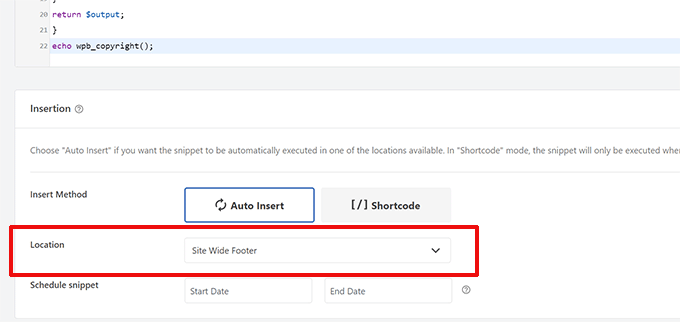
For extra particulars, see our information on find out how to add dynamic copyright dates in WordPress.
7. Randomly Change the Background Colour in WordPress
Do you need to randomly change the background colour in your WordPress weblog for every go to and web page reload? Right here is find out how to simply do that.
First, add this code to your theme’s features file or the WPCode plugin:
$rand = array(‘0’, ‘1’, ‘2’, ‘3’, ‘4’, ‘5’, ‘6’, ‘7’, ‘8’, ‘9’, ‘a’, ‘b’, ‘c’, ‘d’, ‘e’, ‘f’);
$colour=”#”.$rand[rand(0,15)].$rand[rand(0,15)].$rand[rand(0,15)].
$rand[rand(0,15)].$rand[rand(0,15)].$rand[rand(0,15)];
echo $colour;
}
Subsequent, you’ll have to edit the header.php file in your theme. Discover the <physique> tag and add substitute it with this line:
Now you can save your adjustments and go to your web site to see this code in motion.

For extra particulars and alternate strategies, see our tutorial on randomly altering the background colour in WordPress.
8. Replace WordPress URLs
In case your WordPress login web page retains refreshing otherwise you can not entry the admin space, then you should replace WordPress URLs.
A method to do that is by utilizing the wp-config.php file. Nonetheless, in case you try this, then you definitely can not set the right handle on the settings web page. The WordPress URL and Website URL fields will probably be locked and uneditable.
As a substitute, simply add this code to your features file to repair this:
update_option( ‘house’, ‘https://instance.com’ );
Don’t overlook to switch instance.com along with your area title.
As soon as logged in, you may go to the Settings web page within the WordPress admin space and set the URLs.
After that, you need to take away the code you added to the features file or WPCode. In any other case, it would maintain updating these URLs each time your website is accessed.
9. Add Further Picture Sizes in WordPress
WordPress mechanically generates a number of picture sizes once you add a picture. It’s also possible to create further picture sizes to make use of in your theme.
Merely add this code to your theme’s features file or as a WPCode snippet:
add_image_size( ‘homepage-thumb’, 220, 180 ); // Tender Crop Mode
add_image_size( ‘singlepost-thumb’, 590, 9999 ); // Limitless Top Mode
This code creates three new picture sizes of various sizes. Be happy to tweak the code to fulfill your necessities.
You’ll be able to then show a picture dimension anyplace in your theme utilizing this code:
For detailed directions, see our information on creating further picture sizes in WordPress.
WordPress permits theme builders to outline navigation menus after which show them.
You’ll be able to add this code to your theme’s features file or as a brand new WPCode snippet to outline a brand new menu location in your theme:
register_nav_menu(‘my-custom-menu’,__( ‘My Customized Menu’ ));
}
add_action( ‘init’, ‘wpb_custom_new_menu’ );
Now you can go to Look » Menus in your WordPress dashboard and see ‘My Customized Menu’ because the theme location possibility.
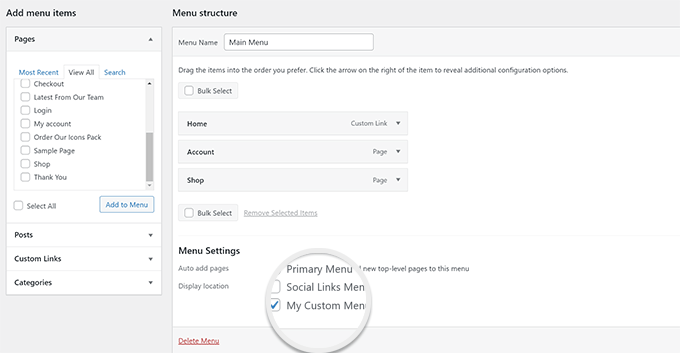
Notice: This code will even work with block themes with the complete website modifying characteristic. Including it would allow the Menus display screen beneath Look.
Now you should add this code to your theme the place you need to show the navigation menu:
wp_nav_menu( array(
‘theme_location’ => ‘my-custom-menu’,
‘container_class’ => ‘custom-menu-class’ ) );
?>
For detailed directions, see our information on find out how to add {custom} navigation menus in WordPress themes.
11. Add Creator Profile Fields
Do you need to add additional fields to your creator profiles in WordPress? You’ll be able to simply try this by including this code to your features file or as a brand new WPCode snippet:
// Add Twitter
$contactmethods[‘twitter’] = ‘Twitter’;
//add Fb
$contactmethods[‘facebook’] = ‘Fb’;
return $contactmethods;
}
add_filter(‘user_contactmethods’,’wpb_new_contactmethods’,10,1);
This code will add Twitter and Fb fields to person profiles in WordPress.
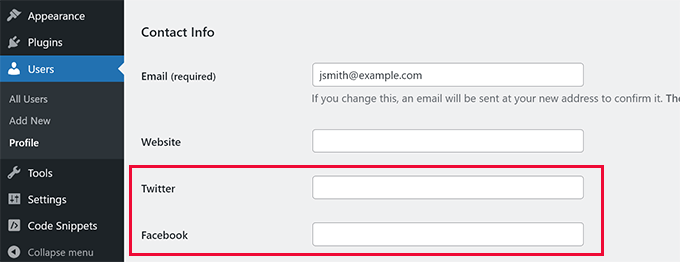
Now you can show these fields in your creator template like this:
You might also need to see our information on including further person profile fields in WordPress registration.
12. Including Widget-Prepared Areas or Sidebars in WordPress Themes
This is without doubt one of the most used code snippets, and lots of builders already find out about including widget-ready areas or sidebars to WordPress themes. But it surely deserves to be on this record for these individuals who don’t know.
You’ll be able to paste the next code in your features.php file or as a brand new WPCode snippet:
perform custom_sidebars() {
$args = array(
‘id’ => ‘custom_sidebar’,
‘title’ => __( ‘Customized Widget Space’, ‘text_domain’ ),
‘description’ => __( ‘A {custom} widget space’, ‘text_domain’ ),
‘before_title’ => ‘<h3 class=”widget-title”>’,
‘after_title’ => ‘</h3>’,
‘before_widget’ => ‘<apart id=”%1$s” class=”widget %2$s”>’,
‘after_widget’ => ‘</apart>’,
);
register_sidebar( $args );
}
add_action( ‘widgets_init’, ‘custom_sidebars’ );
Notice: This code will even work with block themes with the complete website modifying characteristic. Including it would allow the Widgets display screen beneath Look.
Now you can go to the Look » Widgets web page and see your new {custom} widget space.
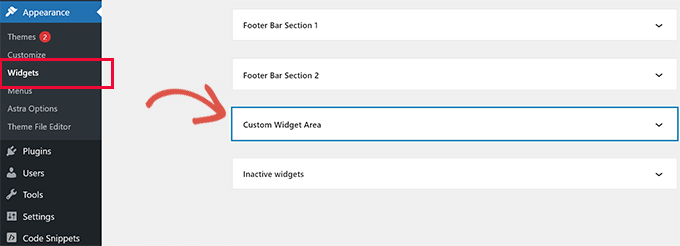
To show this sidebar or widget-ready space in your web site, you’ll want so as to add the next code within the template the place you need to show it:
<!–Default sidebar data goes right here–>
<?php endif; ?>
For extra particulars, see our information on find out how to add dynamic widget-ready areas and sidebars in WordPress.
Have you ever seen blogs that add their ads of their RSS feeds under every put up? You’ll be able to accomplish this simply with a easy perform. Simply paste the next code:
if(is_feed()){
$content material=”This put up was written by Syed Balkhi “.$content material.’Try WPBeginner’;
}
return $content material;
}
add_filter(‘the_excerpt_rss’, ‘wpbeginner_postrss’);
add_filter(‘the_content’, ‘wpbeginner_postrss’);
For extra data, see our information on find out how to add content material and utterly manipulate your RSS feeds.
The put up thumbnail or featured photos are normally solely displayed inside your website design. You’ll be able to simply lengthen that performance to your RSS feed with the next code:
international $put up;
if(has_post_thumbnail($post->ID)) {
$content material=”<p>” . get_the_post_thumbnail($post->ID) .
‘</p>’ . get_the_content();
}
return $content material;
}
add_filter(‘the_excerpt_rss’, ‘rss_post_thumbnail’);
add_filter(‘the_content_feed’, ‘rss_post_thumbnail’);
For extra particulars, see our information on find out how to add put up thumbnails to your WordPress RSS feed.
15. Disguise Login Errors in WordPress
Hackers can use login errors to guess whether or not they entered the mistaken username or password. By hiding login errors in WordPress, you can also make your login space and WordPress web site safer.
Merely add the next code to your theme’s features file or as a brand new WPCode snippet:
return ‘One thing is mistaken!’;
}
add_filter( ‘login_errors’, ‘no_wordpress_errors’ );
Now, customers will see a generic message once they enter an incorrect username or password.
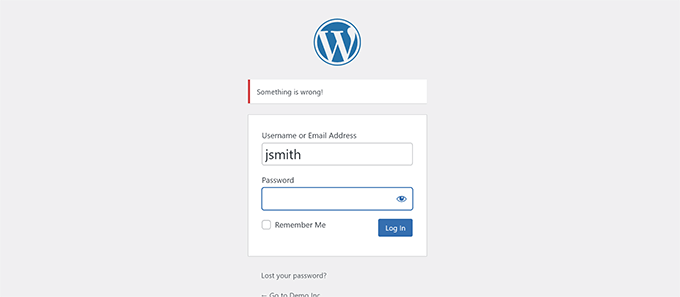
For extra data, see our tutorial on disabling login hints in WordPress error messages.
16. Disable Login by E-mail in WordPress
WordPress permits customers to log in with their username or electronic mail handle. You’ll be able to simply disable login by electronic mail in WordPress by including this code to your features file or as a brand new WPCode snippet:
For extra data, see our information on find out how to disable login by electronic mail characteristic in WordPress.
17. Disable Search Function in WordPress
If you wish to disable your WordPress website’s search characteristic, merely add this code to your features file or in a brand new WPCode snippet:
if ( is_search() ) {
$query->is_search = false;
$query->query_vars[s] = false;
$query->question[s] = false;
if ( $error == true )
$query->is_404 = true;
}}
This code merely disables the search question by modifying it and returning a 404 error as an alternative of search outcomes.
For extra data, see our tutorial on disabling the WordPress search characteristic.
Professional Tip: As a substitute of giving up on WordPress search, we advocate making an attempt out SearchWP. It’s the finest WordPress search plugin in the marketplace that means that you can add a robust and customizable search characteristic to your web site.
Generally you might publish an article with a grammatical error or spelling mistake.
The error goes stay and is distributed to your RSS feed subscribers. When you’ve got electronic mail subscriptions in your WordPress weblog, then these subscribers will even get a notification.
Merely add this code to your theme’s features file or as a brand new WPCode snippet to delay posts in your RSS feed:
international $wpdb;
if ( is_feed() ) {
// timestamp in WP-format
$now = gmdate(‘Y-m-d H:i:s’);
// worth for wait; + machine
$wait=”10″; // integer
// http://dev.mysql.com/doc/refman/5.0/en/date-and-time-functions.html#function_timestampdiff
$machine=”MINUTE”; //MINUTE, HOUR, DAY, WEEK, MONTH, YEAR
// add SQL-sytax to default $the place
$the place .= ” AND TIMESTAMPDIFF($machine, $wpdb->posts.post_date_gmt, ‘$now’) > $wait “;
}
return $the place;
}
add_filter(‘posts_where’, ‘publish_later_on_feed’);
On this code, we used 10 minutes as $wait or delay time. Be happy to alter this to any variety of minutes you need.
For a plugin methodology and extra data, see our detailed information on find out how to delay posts from showing within the WordPress RSS feed.
19. Change Learn Extra Textual content for Excerpts in WordPress
Do you need to change the textual content that seems after the excerpt in your posts? Merely add this code to your theme’s features file or as a brand new WPCode snippet:
return ‘<a category=”more-link” href=”‘ . get_permalink() . ‘”>Your Learn Extra Hyperlink Textual content</a>’;
}
add_filter( ‘the_content_more_link’, ‘modify_read_more_link’ );
Not all web sites want RSS feeds. If you wish to disable RSS feeds in your WordPress website, then add this code to your theme’s features file or as a brand new WPCode snippet:
international $put up;
return ‘<a category=”moretag”
href=”‘. get_permalink($post->ID) . ‘”>Your Learn Extra Hyperlink Textual content</a>’;
}
add_filter(‘excerpt_more’, ‘new_excerpt_more’);
For a plugin methodology and extra data, see our information on find out how to disable RSS feeds in WordPress.
21. Change Excerpt Size in WordPress
WordPress limits excerpt lengths to 55 phrases. You’ll be able to add this code to your features file or as a brand new WPCode snippet if you should change that:
return 100;
}
add_filter(‘excerpt_length’, ‘new_excerpt_length’);
Simply change 100 to the variety of phrases you need to present within the excerpts.
For alternate strategies, you might need to have a look at our information on find out how to customise WordPress excerpts (no coding required).
22. Add an Admin Person in WordPress
When you’ve got forgotten your WordPress password and electronic mail, then you may add an admin person by including this code to your theme’s features file utilizing an FTP consumer:
$person=”Username”;
$cross=”Password”;
$electronic mail=”[email protected]”;
if ( !username_exists( $person ) && !email_exists( $electronic mail ) ) {
$user_id = wp_create_user( $person, $cross, $electronic mail );
$person = new WP_User( $user_id );
$user->set_role( ‘administrator’ );
} }
add_action(‘init’,’wpb_admin_account’);
Don’t overlook to fill within the username, password, and electronic mail fields.
Vital: When you log in to your WordPress website, don’t overlook to delete the code out of your features file.
For extra on this subject, check out our tutorial on find out how to add an admin person in WordPress utilizing FTP.
23. Disable Language Switcher on Login Web page
For those who run a multilingual web site, then WordPress shows a language selector on the login web page. You’ll be able to simply disable it by including the next code to your features.php file or as a brand new WPCode snippet:
24. Present the Complete Variety of Registered Customers in WordPress
Do you need to present the whole variety of registered customers in your WordPress website? Merely add this code to your theme’s features file or as a brand new WPCode snippet:
$usercount = count_users();
$outcome = $usercount[‘total_users’];
return $outcome;
}
// Making a shortcode to show person depend
add_shortcode(‘user_count’, ‘wpb_user_count’);
This code creates a shortcode that means that you can show the whole variety of registered customers in your website.
Now you simply want so as to add the shortcode [user_count] to your put up or web page the place you need to present the whole variety of customers.
For extra data and a plugin methodology, see our tutorial on find out how to show the whole variety of registered customers in WordPress.
Do you need to exclude particular classes out of your WordPress RSS feed? You’ll be able to add this code to your theme’s features file or as a brand new WPCode snippet:
if ( $query->is_feed ) {
$query->set(‘cat’, ‘-5, -2, -3’);
}
return $question;
}
add_filter(‘pre_get_posts’, ‘exclude_category’);
26. Disable URL Hyperlinks in WordPress Feedback
By default, WordPress converts a URL right into a clickable hyperlink in feedback.
You’ll be able to cease this by including the next code to your features file or as a brand new WPCode snippet:
For particulars, see our article on find out how to disable autolinking in WordPress feedback.
27. Add Odd and Even CSS Lessons to WordPress Posts
You will have seen WordPress themes utilizing an odd and even class for WordPress feedback. It helps customers visualize the place one remark ends and the following one begins.
You should utilize the identical approach in your WordPress posts. It appears to be like aesthetically pleasing and helps customers shortly scan pages with a lot of content material.
Merely add this code to your theme’s features file:
international $current_class;
$courses[] = $current_class;
$current_class = ($current_class == ‘odd’) ? ‘even’ : ‘odd’;
return $courses;
}
add_filter ( ‘post_class’ , ‘oddeven_post_class’ );
international $current_class;
$current_class=”odd”;
This code merely provides an odd and even class to WordPress posts. Now you can add {custom} CSS to model them otherwise.
Right here is a few pattern code that will help you get began:
background:#f0f8ff;
}
.odd {
background:#f4f4fb;
}
The tip outcome will look one thing like this:

Want extra detailed directions? Check out our tutorial on find out how to add odd/even courses to your posts in WordPress themes.
28. Add Further File Varieties to Be Uploaded in WordPress
By default, WordPress means that you can add a restricted variety of essentially the most generally used file sorts. Nonetheless, you may lengthen it to permit different file sorts.
Simply add this code to your theme’s features file:
$mime_types[‘svg’] = ‘picture/svg+xml’; //Including svg extension
$mime_types[‘psd’] = ‘picture/vnd.adobe.photoshop’; //Including photoshop information
return $mime_types;
}
add_filter(‘upload_mimes’, ‘my_myme_types’, 1, 1);
This code means that you can add SVG and PSD information to WordPress.
You will have to search out the mime sorts for the file sorts you need to permit after which use them within the code.
For extra on this subject, take a look at our tutorial on find out how to add further file sorts to be uploaded in WordPress.
29. Change Sender Identify in WordPress Emails
WordPress makes use of a non-existent electronic mail handle ([email protected]) to ship outgoing emails by default.
This electronic mail handle may very well be flagged as spam by electronic mail service suppliers.
Utilizing the WP Mail SMTP plugin is the correct approach to repair this.
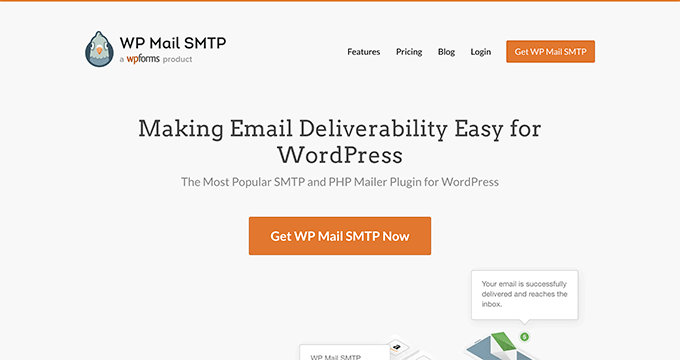
It fixes electronic mail deliverability points and means that you can select an precise electronic mail handle to ship your WordPress emails.
To be taught extra, see our information on find out how to repair WordPress not sending electronic mail situation.
Then again, if you wish to shortly change this to an actual electronic mail handle, then you may add the next code in your features file or as a brand new WPCode snippet:
perform wpb_sender_email( $original_email_address ) {
return ‘[email protected]’;
}
// Operate to alter sender title
perform wpb_sender_name( $original_email_from ) {
return ‘Tim Smith’;
}
// Hooking up our features to WordPress filters
add_filter( ‘wp_mail_from’, ‘wpb_sender_email’ );
add_filter( ‘wp_mail_from_name’, ‘wpb_sender_name’ );
Don’t overlook to switch the e-mail handle and title with your individual data.
The issue with this methodology is that WordPress continues to be utilizing the mail() perform to ship emails, and such emails are most probably to finish up in spam.
For higher alternate options, see our tutorial on find out how to change the sender title in outgoing WordPress emails.
30. Add an Creator Information Field in WordPress Posts
For those who run a multi-author website and need to showcase creator bios on the finish of your posts, then you may do that methodology.
Begin by including this code to your features file or as a brand new WPCode snippet:
international $put up;
// Detect if it’s a single put up with a put up creator
if ( is_single() && isset( $post->post_author ) ) {
// Get creator’s show title
$display_name = get_the_author_meta( ‘display_name’, $post->post_author );
// If show title just isn’t out there then use nickname as show title
if ( empty( $display_name ) )
$display_name = get_the_author_meta( ‘nickname’, $post->post_author );
// Get creator’s biographical data or description
$user_description = get_the_author_meta( ‘user_description’, $post->post_author );
// Get creator’s web site URL
$user_website = get_the_author_meta(‘url’, $post->post_author);
// Get hyperlink to the creator archive web page
$user_posts = get_author_posts_url( get_the_author_meta( ‘ID’ , $post->post_author));
// Get Person Gravatar
$user_gravatar = get_avatar( get_the_author_meta( ‘ID’ , $post->post_author) , 90 );
if ( ! empty( $display_name ) )
$author_details=”<p class=”author_name”>About ” . $display_name . ‘</p>’;
if ( ! empty( $user_description ) )
// Creator avatar and bio will probably be displayed if creator has crammed in description.
$author_details .= ‘<p class=”author_details”>’ . $user_gravatar . nl2br( $user_description ). ‘</p>’;
$author_details .= ‘<p class=”author_links”><a href=”‘. $user_posts .'”>View all posts by ‘ . $display_name . ‘</a>’;
// Verify if creator has an internet site of their profile
if ( ! empty( $user_website ) ) <a href=”‘ . $user_website .'” goal=”_blank” rel=”nofollow noopener”>Web site</a></p>’;
else {
// if there isn’t a creator web site then simply shut the paragraph
$author_details .= ‘</p>’;
}
// Go all this data to put up content material
$content material = $content material . ‘<footer class=”author_bio_section” >’ . $author_details . ‘</footer>’;
}
return $content material;
}
// Add our perform to the put up content material filter
add_action( ‘the_content’, ‘wpb_author_info_box’ );
// Enable HTML in creator bio part
remove_filter(‘pre_user_description’, ‘wp_filter_kses’);
Subsequent, you have to so as to add some {custom} CSS to make it look higher.
You should utilize this pattern CSS as a place to begin:
background: none repeat scroll 0 0 #F5F5F5;
padding: 15px;
border: 1px stable #ccc;
}
.author_name{
font-size:16px;
font-weight: daring;
}
.author_details img {
border: 1px stable #D8D8D8;
border-radius: 50%;
float: left;
margin: 0 10px 10px 0;
}
That is how your creator field will seem like:

For a plugin methodology and extra detailed directions, take a look at our article on find out how to add an creator data field in WordPress posts.
31. Disable XML-RPC in WordPress
XML-RPC is a technique that permits third-party apps to speak along with your WordPress website remotely. This might trigger safety points and will be exploited by hackers.
To show off XML-RPC in WordPress, add the next code to your features file or as a brand new WPCode snippet:
It’s possible you’ll need to learn our article on find out how to disable XML-RPC in WordPress for extra data.
32. Robotically Hyperlink Featured Photographs to Posts
In case your WordPress theme doesn’t mechanically hyperlink featured photos to full articles, then you may do that methodology.
Merely add this code to your theme’s features file or as a brand new WPCode snippet:
If (! is_singular()) {
$html=”<a href=”” . get_permalink( $post_id ) . ‘” title=”‘ . esc_attr( get_the_title( $post_id ) ) . ‘”>’ . $html . ‘</a>’;
return $html;
} else {
return $html;
}
}
add_filter( ‘post_thumbnail_html’, ‘wpb_autolink_featured_images’, 10, 3 );
It’s possible you’ll need to learn our article on find out how to mechanically hyperlink featured photos to posts in WordPress.
33. Disable Block Editor in WordPress
WordPress makes use of a contemporary and intuitive editor for writing content material and modifying your web site. This editor makes use of blocks for commonly-used content material and format components, which is why it’s referred to as the Block Editor.
Nonetheless, you might want to make use of the older Basic Editor in some use instances.
The best approach to disable the block editor is by utilizing the Basic Editor plugin. Nonetheless, in case you don’t need to use a separate plugin, then simply add the next code to your features file or as a brand new WPCode snippet:
add_filter(‘use_block_editor_for_post’, ‘__return_false’, 5);
For extra particulars, see our tutorial on find out how to disable the Block Editor and use the Basic Editor.
34. Disable Block Widgets in WordPress
WordPress switched from basic widgets to dam widgets in WordPress 5.8. The brand new block widgets are simpler to make use of and provide you with extra design management than basic widgets.
Nonetheless, some customers should still need to use basic widgets. In that case, you should use the next code in your theme’s features file or as a brand new WPCode snippet:
For extra particulars, see our article on find out how to disable widget blocks (restore basic widgets).
35. Show the Final Up to date Date in WordPress
When guests view a put up or web page in your WordPress weblog, your WordPress theme will present the date the put up was revealed. That is superb for many blogs and static web sites.
Nonetheless, WordPress can also be utilized by web sites the place previous articles are usually up to date. In these publications, displaying the date and time the put up was final modified is crucial.
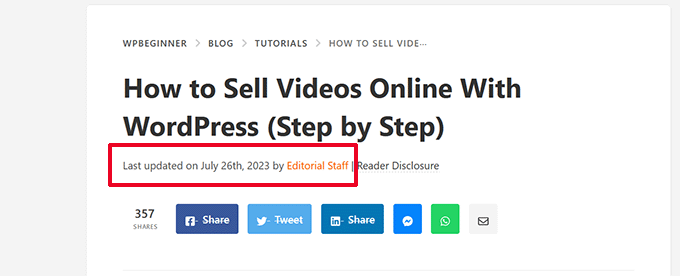
You’ll be able to present the final up to date date utilizing the next code in your theme’s features file or as a brand new WPCode snippet:
$u_modified_time = get_the_modified_time( ‘U’ );
// Solely show modified date if 24hrs have handed for the reason that put up was revealed.
if ( $u_modified_time >= $u_time + 86400 ) {
$updated_date = get_the_modified_time( ‘F jS, Y’ );
$updated_time = get_the_modified_time( ‘h:i a’ );
$up to date = ‘<p class=”last-updated”>’;
$up to date .= sprintf(
// Translators: Placeholders get changed with the date and time when the put up was modified.
esc_html__( ‘Final up to date on %1$s at %2$s’ ),
$updated_date,
$updated_time
);
$up to date .= ‘</p>’;
echo wp_kses_post( $up to date );
}
For alternate strategies and extra particulars, see our information on find out how to show the final up to date date in WordPress.
36. Use Lowercase Filenames for Uploads
For those who run a multi-author web site, then authors could add photos with filenames in higher and lowercase.
Including the next code ensures that every one filenames are in lowercase:
Notice: The code is not going to change filenames for current uploads. For alternate strategies, see our tutorial on find out how to rename photos and media information in WordPress.
37. Disable WordPress Admin Bar on Frontend
By default, WordPress shows the admin bar on the high when a logged-in person views your web site.
You’ll be able to disable the admin bar for all customers besides website directors. Merely add the next code to your features file or as a brand new WPCode snippet:
add_filter( ‘show_admin_bar’, ‘__return_false’ );
For extra particulars, see our information on find out how to disable the WordPress admin bar for all customers besides directors.
38. Change Howdy Admin Textual content in Admin Space
WordPress shows a ‘Howdy Admin’ greeting within the WordPress dashboard. ‘Admin’ is changed by the logged-in person’s title.
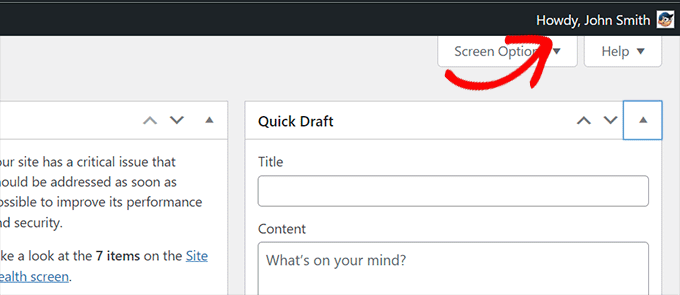
You’ll be able to change the default greeting to your individual by including the next code in your features file or as a brand new WPCode snippet:
// Edit the road under to set what you need the admin bar to show intead of “Howdy,”.
$new_howdy = ‘Welcome,’;
$my_account = $wp_admin_bar->get_node( ‘my-account’ );
$wp_admin_bar->add_node(
array(
‘id’ => ‘my-account’,
‘title’ => str_replace( ‘Howdy,’, $new_howdy, $my_account->title ),
)
);
}
add_filter( ‘admin_bar_menu’, ‘wpcode_snippet_replace_howdy’, 25 );
For extra particulars, see our article on altering the ‘Howdy Admin’ message in WordPress.
39. Disable Code Modifying in Block Editor
The block editor means that you can change to the Code Editor. This is useful if you should add some HTML code manually.
Nonetheless, you might need to maintain this characteristic restricted to website directors.
You’ll be able to add the next code to your features file or as a WPCode snippet to realize this:
$settings[‘codeEditingEnabled’] = current_user_can( ‘manage_options’ );
return $settings;
} );
40. Disable Plugin / Theme File Editor
WordPress comes with a built-in editor the place you may edit plugin information. You’ll be able to see it by going to the Plugins » Plugin File Editor web page.

Equally, WordPress additionally features a file editor for traditional themes at Look » Theme File Editor.
Notice: For those who use a block theme, then the theme file editor just isn’t seen.
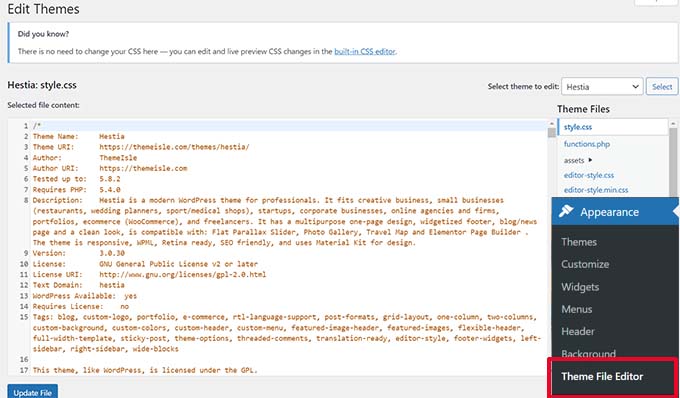
We don’t advocate utilizing these editors for making adjustments to your theme or plugin. A tiny mistake in code could make your web site inaccessible to all customers.
To disable the plugin/theme editor, add the next code to your features file or as a WPCode snippet:
if ( ! outlined( ‘DISALLOW_FILE_EDIT’ ) ) {
outline( ‘DISALLOW_FILE_EDIT’, true );
}
For extra particulars, see our tutorial on find out how to disable the plugin/theme editor in WordPress.
41. Disable New Person Notification Emails
By default, WordPress sends an electronic mail notification when a brand new person joins your WordPress web site.
For those who run a WordPress membership web site or require customers to signup, then you’re going to get a notification every time a person joins your web site.
To show off these notifications, you may add the next to your features file or as a brand new WPCode snippet:
if ( empty( $notify ) || ‘admin’ === $notify ) {
return;
} elseif ( ‘each’ === $notify ) {
// Ship new customers the e-mail however not the admin.
$notify = ‘person’;
}
wp_send_new_user_notifications( $user_id, $notify );
}
add_action(
‘init’,
perform () {
// Disable default electronic mail notifications.
remove_action( ‘register_new_user’, ‘wp_send_new_user_notifications’ );
remove_action( ‘edit_user_created_user’, ‘wp_send_new_user_notifications’ );
// Change with {custom} perform that solely sends to person.
add_action( ‘register_new_user’, ‘wpcode_send_new_user_notifications’ );
add_action( ‘edit_user_created_user’, ‘wpcode_send_new_user_notifications’, 10, 2 );
}
);
For extra particulars, see our tutorial on find out how to disable new person electronic mail notifications in WordPress.
42. Disable Computerized Replace E-mail Notifications
Often, WordPress could mechanically set up safety and upkeep updates or replace a plugin with a important vulnerability.
It sends an automated replace electronic mail notification after every replace. For those who handle a number of WordPress web sites, then you might get a number of such emails.
You’ll be able to add this code to your features file or as a brand new WPCode snippet to show off these electronic mail notifications:
add_filter( ‘auto_core_update_send_email’, ‘__return_false’ );
// Disable auto-update emails for plugins.
add_filter( ‘auto_plugin_update_send_email’, ‘__return_false’ );
// Disable auto-update emails for themes.
add_filter( ‘auto_theme_update_send_email’, ‘__return_false’ );
To be taught extra, see our article on find out how to disable automated replace emails in WordPress.
We hope this text helped you be taught some new helpful tips for the features.php file in WordPress. You might also need to see our final information to spice up WordPress velocity and efficiency and our skilled picks for the most effective code editors for Mac and Home windows.
For those who favored this text, then please subscribe to our YouTube Channel for WordPress video tutorials. It’s also possible to discover us on Twitter and Fb.




